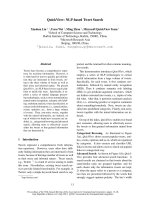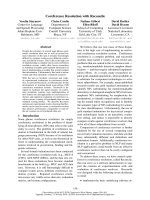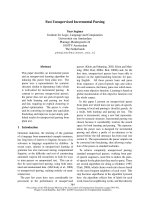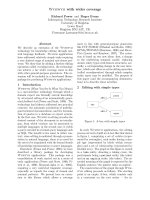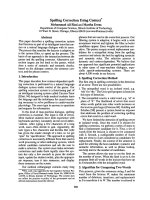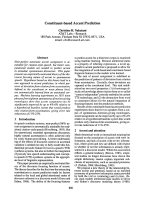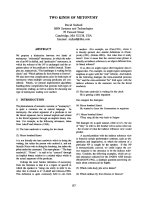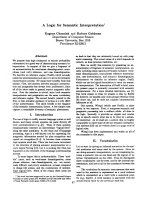Báo cáo khoa học: WORKSHOPS WS 1 Nanotherapeutics pdf
Bạn đang xem bản rút gọn của tài liệu. Xem và tải ngay bản đầy đủ của tài liệu tại đây (122.48 KB, 6 trang )
WORKSHOPS
WS 1 Nanotherapeutics
WS 1–1
Nanotherapeutics through polymer chemistry:
supra-molecular nanocarriers for gene and
drug delivery
K. Kataoka
The University of Tokyo, Materials Engineering, Tokyo, JAPAN
Polymeric micelle, the self-assembly of block copolymers with
core-shell architecture, is a promising nanocarrier for drug and
gene delivery. There are several relevant properties in polymeric
micelle as nanocarrier systems, such as longevity in blood circula-
tion, tissue-penetrating ability, spatial and temporal controlled
drug release, and reduced inherent toxicity of cytotoxic reagents.
Also, engineering of the block copolymer structure allows the
preparation of polymeric micelles with integrated smart func-
tions, such as targetability as well as stimuli-sensitivity. This pre-
sentation overviews the recent achievements as well as the future
perspectives of polymeric micelles as smart nanocarriers for drug
and nucleic acid delivery. Notable anti-tumor efficacy against
hypovascular cancer, including pancreatic cancer and diffused-
type stomach cancer, of the doxorubicin-incorporated polymeric
micelles with pH-responding property was demonstrated to
emphasize a promising utility of the nanocarrier-modulated che-
motherapy for the treatment of intractable cancers. Gene-loaded
polymeric micelles were applied as non-viral vectors in the fields
of regenerative medicine, particularly bone regeneration. Genera-
tion of new bone in experimental animals was successfully
achieved by transducting genes encoding differentiation factors
using polymeric micellar carriers. Gene therapy by polymeric
micelles was also demonstrated for intractable cardiovascular dis-
ease, pulmonary hypertension, by intratracheal transfer of thera-
peutic gene. Further, the supramolecular assemblies, including
polymeric micelles, polymer vesicles, and photosensitive dendri-
mer assemblies, were utilized as nanodevices directing to the new
medical paradigm of smart nanotheranostic systems controlled
by external physical stimuli, particularly, photo illumination
(nano-photomedicine).
WS 1–2
Polymeric nanomedicines: intracellular
trafficking and subcellular fate
J. Kopecek
University of Utah, Pharmaceutical Chemistry, Salt Lake City
Utah, USA
The concept of polymeric nanomedicines was developed to
address the lack of specificity of low-molecular weight drugs for
malignant cells. The design principles of the first-generation con-
jugates include: a polymer-drug linker that is stable during trans-
port and able to release the drug in the lysosomal compartment
of target cells at a predetermined rate, adequate physicochemical
properties of the conjugate (solubility, conformation in the bio-
logical environment), and the capability to target the diseased
cells or tissue by an active or a passive mechanism. Clinical trials
of nanomedicines demonstrated reduced side effects, increased
therapeutic efficacy, and improved patient compliance. Although
the targetability of macromolecular therapeutics to cell surface
antigens/receptors is well established, the manipulation of their
subcellular fate needs to be studied. Efforts are underway to
design, synthesize, and evaluate a second generation of anticancer
nanomedicines with enhanced efficiency. The augmented effec-
tiveness of novel conjugates will be derived from: longer intravas-
cular half-life; controlled biodegradability of the main chain; and
potential for double targeting: to tumor cells and to a crucial
subcellular organelle. The lecture will discuss recent results of cel-
lular and subcellular targeting of N-(2-hydroxypropyl)meth-
acrylamide (HPMA) copolymer – drug conjugates: structural
factors influential in the kinetics of translocation of macromole-
cules from the cytoplasm into the nucleus, the effect of the
valence of HPMA copolymer – Fab fragment conjugates on the
binding to B cell antigens, subcellular targeting of photosensitizer
mesochlorin e6 to mitochondria mediated by lipophilic triphenyl-
phosphonium cation, and subcellular targeting to nucleus facili-
tated by glucocorticoid receptor – ligand recognition.
WS 1–3
Multifunctional nanocarriers for delivery of
drugs, genes, and diagnosticals in the body
V. P. Torchilin
Center for Pharmaceutical Biotechnology and Nanomedicine
Northeastern, University Boston, MA, USA
Various pharmaceutical nanocarriers, including liposomes and
polymeric micelles, are frequently used for the delivery of a
broad variety of both soluble and poorly soluble pharmaceuti-
cals. Using nanoparticulate pharmaceutical carriers to enhance
the in vivo efficiency of many drugs is now well established. Now,
within the frame of this concept, it is important to develop multi-
functional stimuli-responsive nanocarriers, i.e. nanocarriers that,
depending on the particular requirements, can circulate long; tar-
get the site of the disease via both non-specific and/or specific
mechanisms, such as enhanced permeability and retention effect
(EPR) and ligand-mediated recognition; respond local stimuli
characteristic of the pathological site by, for example, releasing
an entrapped drug or deleting a protective coating under the
slightly acidic conditions inside tumors facilitating thus the con-
tact between drug-loaded nanocarriers and cancer cells; and even
provide an enhanced intracellular delivery of an entrapped drug.
Additionally, these carriers can be supplied with contrast moieties
to follow their real-time biodistribution and target accumulation.
Among new developments to be considered in the area of multi-
functional pharmaceutical nanocarriers are: drug- or DNA-
loaded delivery systems additionally decorated with cell-penetrat-
ing peptides for the enhanced intracellular delivery; ‘smart’ multi-
functional drug delivery systems, which can reveal/expose
temporarily hidden functions under the action of certain local
stimuli characteristic for the pathological zone; new means for
controlled delivery and release of siRNA; and nanocarrier-based
new targeted contrast agents for diagnostic imaging.
WS 1–4
Programmed polymer complexes for targeted
pDNA and siRNA therapy
E. Wagner
LMU Munich, Department of Pharmacy, Munich, GERMANY
Nanoparticles transporting therapeutic nucleic acids such as plas-
mid DNA, dsRNA or siRNA have to be pre-programmed to
Workshops Abstracts
FEBS Journal 276 (Suppl. 1) 85–90 (2009) ª 2009 The Authors Journal compilation ª 2009 Federation of European Biochemical Societies 85
alter their properties during the drug delivery process, to make
them most effective for the different extra- and intra-cellular
steps (1–3). For this purpose molecular chemical sensors (such as
bioreducible and pH-sensitive bonds or conformations) are incor-
porated able to respond to the relevant intracellular biological
(e.g. endosomal acidification) or physical stimuli (light or hyper-
thermia). Targeting to cell surface receptors enhances specificity
and efficacy, as demonstrated for EGFR targeted polyplexes con-
taining therapeutic RNA poly-Inosine-Cytidine (4) or transferrin-
coated siRNA polyplexes (5). Delivery processes can be moni-
tored by innovate biooptical imaging tools including near infra-
red quantum dot in vivo imaging in mice.
References:
1. Wagner E. Expert Op. Biol. Ther. 2007; 7: 587–593.
2. Meyer M, Philipp A, Oskuee R, Schmidt C & Wagner E. J.
Am. Chem. Soc. 2008; 130: 3272–3273.
3. Knorr V, Russ V, Allmendinger L, Ogris M & Wagner E. Bio-
conjug. Chem. 2008; 19: 1625–1634.
4. Shir A, Ogris M, Wagner E & Levitzki A. PLoS Med. 2006; 3:
e6.
5. Tietze N, Pelisek J, Philipp A, Roedl W, Merdan T, Tarcha P,
Ogris M & Wagner E. Oligonucleotides 2008; 18: 161–174.
WS 1–5
Polymer nanomaterials for CNS drug delivery
A. Kabanov
University of Nebraska Medical Center, Pharmaceutical Sciences,
Omaha, USA
Neurodegenerative and infectious disorders including Alzheimer’s
and Parkinson’s diseases, amyotrophic lateral sclerosis, and
stroke are rapidly increasing as population’s age. Alzheimer’s dis-
ease alone currently affects 4.5 million Americans, and more than
$100 billion is spent per year on medical and institutional care
for affected people. Such numbers will double in the ensuing dec-
ades. Currently disease diagnosis for all disorders is made, in
large measure, on clinical grounds as laboratory and neuroimag-
ing tests confirm what is seen by more routine examination.
Achieving early diagnosis would enable improved disease out-
comes. Drugs, vaccines or regenerative proteins present ‘real’
possibilities for positively affecting disease outcomes, but are lim-
ited in that their entry into the brain is commonly restricted
across the blood-brain barrier. This presentation will review high-
lights how these obstacles can be overcome by polymer science
and nanotechnology. Specific examples developed in our work
include (i) inhibition of drug efflux transport systems in the
blood-brain barrier by amphiphilic block copolymers, (ii) chemi-
cal modification of proteins with hydrophobic anchors groups
and amphiphilic polymers to enhance their transport across the
blood-brain barrier, (iii) development of nanogels capable of car-
rying antisense oligonucleotides and siRNA across the blood-
brain barrier, (iv) cell-mediated delivery of nanozymes to the
brain. Such approaches may improve diagnostic and therapeutic
outcomes. New developments in polymer science coupled with
cell based delivery strategies support the notion that diseases that
now have limited therapeutic options can show improved out-
comes by advances in nanomedicine. The work is supported by
the United States National Institutes of Heath.
WS 1–6
Immunotherapy of cancer with polymeric
prodrugs: from dream to reality
B. Rihova
1
, T. Etrych
2
, M. Kovar
1
, J. Strohalm
2
, L. Kovar
1
,
O. Hovorka
1
, M. Sirova
1
, D. Plocova
2
, P. Chytil
2
, V. Subr
2
and
K. Ulbrich
2
1
Institute of Microbiology AS CR v.v.i., Immunology and
Gnotobiology, CZECH REPUBLIC,
2
Institute of Macromolecular
Chemistry AS CR v.v.i., Biomedical polymers, CZECH
REPUBLIC
The majority of clinically approved anticancer drugs are charac-
terized by a high systemic toxicity, including immunotoxicity.
Water-soluble polymeric therapeutics based on N-(2-hydroxypro-
pyl) methacrylamide (HPMA) has been emerged as efficient ther-
apeutics because they are able to not only directly destroy cancer
cells but also elicit systemic tumor-specific anticancer responses.
Such polymeric drugs have been shown to be highly effective
against experimental tumors induced in mice and rats. It was
possible to establish a protective anticancer immunity in normal
mice with an intact immune system, but in immunodeprived nude
(athymic) mice there were no long-term cancer survivors. It could
be shown that the polymeric drug therapy generated a tumor-spe-
cific long-lasting memory, which was based mainly an effectors
cells of specific immunity, the CD8
+
cytotoxic T lymphocytes
(CTLs). Moreover, such resistance can be induced only within an
optimal time frame: experimental mice treated either too early
(i.e. a few days after transplantation of cancer cells) or too late
(i.e. when the immune system is already exhausted) did not estab-
lish systemic cancer resistance. This suggests that treatment that
might be presumed to be very effective, that is, treatment started
either very early or with a highly aggressive dose, might actually
eliminate cancer cells before they can supply the immune system
with a sufficient amount of antigens for effector-cell activation.
The first clinical observation together with the laboratory data
suggests non-toxic, anti-tumor and immunomobilizing character
of polymeric drugs based on HPMA similarly as it was docu-
mented in experimental animals. However, more data and addi-
tional studies are needed in order to make a rational and
balanced conclusion and suggest them as a novel approach for
synergized chemotherapy and immunotherapy of cancer.
Acknowledgement: This work was supported by grants from
Academy of Sciences of the Czech Republic (no.
KAN200200651) and the Grant Agency of the Academy of
Sciences of the Czech Republic (no.IAAX00500803)
Abstracts Workshops
86 FEBS Journal 276 (Suppl. 1) 85–90 (2009) ª 2009 The Authors Journal compilation ª 2009 Federation of European Biochemical Societies
WS 2 Glycomic Technologies
WS 2–1
Novel glycan-binding receptors identified by
genomic analysis
K. Drickamer and M. E. Taylor
Imperial College London, Department of Life Sciences, London,
UK
Mammalian receptors that recognise specific glycans are responsi-
ble for glycoprotein trafficking in cells and organisms, cell–cell
adhesion and immunity to viral, bacterial and fungal pathogens.
Glycomic and genomic analyses suggest that there are thousands
of glycan structures expressed on human cells and pathogens, but
only about a hundred different human sugar-binding receptors
have been described to date. Using the structures of known carbo-
hydrate-recognition domains as templates, we have been examin-
ing the human genome for additional sugar-binding domains and
have identified several novel glycan-binding receptors. One of
these has been examined in detail and is found to be expressed on
B cells. Affinity chromatography, solid phase binding assays and
glycan array analysis reveal that the C-type carbohydrate-recogni-
tion domain in the extracellular domain of the receptor binds gly-
cans with terminal alpha-linked mannose or fucose residues.
Compared to other known glycan-binding receptors, the receptor
contains an unusually large intracellular domain that consists of
multiple sequence motifs, including phosphorylated tyrosine resi-
dues, that allow it to interact with signalling molecules such as
Grb2. As the receptor is expressed on a specialized population of
proliferating B cells in germinal centres, we have suggested the
named prolectin. This novel receptor has the potential to function
in carbohydrate-mediated communication between B cells and
other cells in the germinal centre and elsewhere.
WS 2–2
NMR studies of free and protein-bound
glycomimetics
J. Jimenez-Barbero
CIB-CSIC, Protein Science, Madrid, SPAIN
Molecular recognition by specific targets is at the heart of the life
processes. In recent years, it has been shown that the interactions
between proteins (lectins, enzymes, antibodies) and carbohydrates
mediate a broad range of biological activities, from fertilization,
embryogenesis, and tissue maturation, to pathological processes.
The elucidation of the mechanisms that govern how sugars are
accommodated in the binding sites of these receptors is currently
a topic of interest. Thus, the determination of the structural and
conformational factors and the physicochemical features which
govern the molecular recognition of these molecules is of para-
mount importance. This presentation is focused on the applica-
tion of NMR methods to the study of molecular recognition
processes between a variety of polypeptides and carbohydrate
molecules and their analogues.
WS 2–3
Mass spectrometric stratergies for glycomics
and glycoproteomics
S. Haslam
Imperial College London, Division of Molecular Biosciences,
London, UK
Ultra-high sensitivity mass spectrometric strategies incorporating
MALDI-MS/MS and nano-electrospray(ES)-MS/MS enable very
complex mixtures of glycoproteins from biological extracts of
cells and tissues to be screened thereby revealing the types of gly-
cans present and, importantly, providing clues to structures that
are likely to be functionally important. Data emerging from some
of our glycomic programmes of collaborative research, which are
helping to provide new insights into the functions of glycans in
biological systems, will be described. In addition our participa-
tion in international glycobiology consortia will be discussed.
These include the Analytical Core of the NIH Consortium for
Functional Glycomics, which is located at Imperial College,
which is employing glycomic methodologies to study murine and
human haematopoietic cell populations in order to provide a gly-
comics data resource for the glycobiology community. Informa-
tion emerging from this programme will be highlighted together
with progress on the development of informatic tools to manage
the large volumes of data being acquired.
WS 2–5
Protein engineering of carbohydrate binding
proteins – understanding the recognition
phenomena
M. Wimmerova
Masaryk University, National Centre for Biomolecular Reseach
and Department of Biochemistry, Brno, CZECH REPUBLIC
Carbohydrate-mediated recognition plays an important role in
adhesion of parasitic organisms to the surface of the host cell as
the first step of their invasion and infectivity. Protein–carbohy-
drate interactions are generally characterised by a low affinity for
monovalent ligands that is balanced by multivalency resulting in
high avidity for ligands with several potential epitops available,
such as complex glycans or cell surface. However, recent charac-
terisation of bacterial lectins involved in pathogenesis has demon-
strated their much higher affinity even towards monosaccharide
than that observed for plant or animal lectins (1). The contribu-
tion is focused on few examples where a combination of experi-
mental methods (isothermal titration microcalorimetry, surface
plasmon resonance, X-ray crystallography) with computational
approaches can bring a significant profit for better understanding
of protein-carbohydrate interactions on molecular level (2,3).
Insight into structure correlation with function analysis of high-
affinity lectins allows for construction of carbohydrate-binding
proteins with tuned affinity and specificity for biotechnology and
bioanalytical purposes.
References:
1. Imberty A, Mitchell EP & Wimmerova
´
M. Curr. Opin. Struct.
Biol. 2005; 15: 523–534.
2. Adam J, Pokorna
´
M, Sabin C, Mitchell EP, Imberty A &
Wimmerova
´
M. BMC Struct. Biol. 2007; 7: 36.
3. Adam J, Krı
´
I
¨
Z, Prokop M, Wimmerova
´
M & Koca J.
J. Chem. Inf. Model. 2008; 48: 2234–2242.
Workshops Abstracts
FEBS Journal 276 (Suppl. 1) 85–90 (2009) ª 2009 The Authors Journal compilation ª 2009 Federation of European Biochemical Societies 87
WS 2–6
Identification and characterisation of lectins in
several tick species
J. Sterba
1
, J. Dupejova
1
, M. Fiser
1
, M. Golovchenko
2
,
N. Rudenko
2
and L. Grubhoffer
1
1
University of South Bohemia, Faculty of Science, Ceske
Budejovice, CZECH REPUBLIC,
2
Biology Centre of ASCR,
Institute of Parasitology, Ceske Budejovice, CZECH REPUBLIC
FReD (fibrinogen-related domain) proteins are lectins with possi-
ble functions in immunity of invertebrates. Previously, a FReD
protein from the hemolymph of the tick Ornithodoros moubata,
Dorin M, was isolated and characterised. In the present study,
FReD proteins with hemagglutination acitvity (HA) were identi-
fied in hemolymph of ticks Dermacentor marginatus, Rhipicephal-
lus appendiculatus, R. pulchellus, and R. sanguineus and
characterised. Several FReD proteins were detected using anti-
bodies directed against Dorin M, Ixodes ricinus hemolymph lec-
tin, and hemagglutination acitivity of O. moubata and I. ricinus
ticks. All identified FReD proteins are modified by truncated
high-mannose glycans. Hemagglutination activity of hemolymph
of the studied ticks was inhibited predominantly by N-acetylh-
exosamines and sialoglycoproteins. All tick species contained a
hemelipoglycoprotein-like protein, described previously also in D.
variabilis. Nucleotide sequence of novel protein containing fibrin-
ogen-related domain was identified in ticks of species D. margina-
tus, Haemaphysalis punctata, and Hyalomma impeltatus. FReD
proteins of D. marginatus localised in hemocytes, salivary glands,
and gut cells.
Acknowledgement: Supported by the KJB600960906 research
project of the Grant agency of the Academy of sciences of the
Czech Republic and by the LC06009 research centre project of
the Ministry of Education, Sport and Youth of the Czech
Republic.
Abstracts Workshops
88 FEBS Journal 276 (Suppl. 1) 85–90 (2009) ª 2009 The Authors Journal compilation ª 2009 Federation of European Biochemical Societies
WS 3 Emerging Proteomic Technologies
WS 3–1
Mapping and measuring proteomes
R. Aebersold
Institute of Molecular Systems Biology, Zurich, SWITZERLAND
The human genome project has taught us that a complete map –
in the case of the genome project the complete genomic sequence
– along with computational tools to navigate the map – represent
invaluable resources for experimental and theoretical biologists.
A main consequence of such a complete map is that all the bio-
logical processes have to be explainable with the components that
constitute the map. Proteomics has not reached the stage that
complete maps are available but the urgent need for their genera-
tion is now widely recognized. In this presentation we will discuss
experimental and computational challenges related to the genera-
tion of complete proteomic maps. We will also discuss recent
technical advances towards complete proteome analysis and
describe software tools and data resources that will transform
proteomics from perpetual proteome mapping to accurate prote-
ome measurement.
Further reading:
Kuster B, Schirle M, Mallick P & Aebersold R. Nature Rev.
Mol. Cell. Biol. 2005; 6(7): 577–583.
Brunner E, Ahrens CH, Mohanty S, Baetschmann H, Loevenich
S, Potthast F, Deutsch EW, Panse C, de Lichtenberg U, Rinner
O, Lee H, Pedrioli PG, Malmstroem J, Koehler K, Schrimpf S,
Krijgsveld J, Kregenow F, Heck AJ, Hafen E, Schlapbach R &
Aebersold R. Nature Biotechnol. 2007; 5: 576–583.
Nesvizhskii A, Vitek O & Aebersold R. Nature Methods 2007; 4:
787–797.
Deutsch EW, Lam H & Aebersold R. EMBO Reports 2008; 9:
429–434.
Lange V, Picotti P, Domon B & Aebersold R. Molecular Systems
Biology 2008; 4: 222.
Picotti P, Lam H, Campbell D, Deutsch E, Mirzaei H, Ranish J,
Domon B & Aebersold R. Nature Methods 2008; 5: 913–914.
Bodenmiller B, Campbell D, Gerrits B, Lam H, Jovanovic M,
Picotti P, Schlapbach R & Aebersold R. Nature Biotechnol.
2008; 26: 1339–1340.
WS 3–2
Chalenges in guantitative proteomics and
posttranslational protein modifications
M. Mann
Max-Planck Institute of Proteomics, GERMANY
WS 3–3
Glycoproteomics: past, present and future
B. Tissot
1
, S. J. North
1
, A. Ceroni
1
, P. Pang
1
, M. Panico
1
,
F. Rosati
2
, A. Capone
2
, S. M. Haslam
1
, A. Dell
1
and
H. R. Morris
1,3
1
Division of Molecular Biosciences – Faculty of Natural Sciences,
Imperial College London, London, UK,
2
Department of Evolution-
ary Biology, University of Siena, Siena, ITALY,
3
M-SCAN Ltd.,
Wokingham, Berks, UK
The study of protein glycosylation, commonly known as glyco-
proteomics, will be reviewed, beginning with the origins of the
subject in the early 1970s, shortly after mass spectrometry was
first applied to protein sequencing. Brief discussion of the devel-
opment of mass mapping strategies together with early structural
studies including antifreeze glycoproteins and the discovery of
the glycosylation of human Interleukin 2, will give an insight into
current strategies for glycoprotein analyses. These will then be
illustrated with details of our developmental biology research,
utilising ES Q-TOF and MALDI TOF-TOF technologies, with
examples from human glycodelin and from the characterisation
of the O-glycans of gp273 from Unio elongatulus, believed to be
the ligand for sperm-egg binding during fertilisation. Such com-
plex studies are aided by the recent development of powerful
automated and interactive informatic tools such as Cartoonist,
Peptoonist and GlycoWorkbench, and their use in unravelling the
complexity of glycoproteomic interpretations will be described.
Overall, the advances in glycoproteomics methodology over the
past four decades, building on the early concepts of biomolecular
mass spectrometric strategy and tactics, are now reaching a point
where despite the inherent complexity of the field, automated
analyses, comparable to current proteomics methodologies, may
be only another decade away!
WS 3–4
Pathway proteomics using proteinarrays
J. van Oostrum
Zeptosens, a Division of Bayer (Schweiz) AG, Witterswil,
SWITZERLAND
Molecular signalling pathways are frequently triggered by extra-
cellular molecules binding receptors and activating relay systems
inside cells, leading to processes that affect cellular behaviour
and fate. For many genetic disorders a link between disease and
signalling pathways have been established consequently a system-
atic analysis of dynamic cellular networks provides an opportu-
nity for pharmaceutical discovery, by taking into consideration
the complex biological context of drug targets, rather than
observing the targets in isolation. Such analyses are, perhaps, ide-
ally suited for a systems biology approach that integrates experi-
mental data with computational modeling with the aims of
discovering and validating new drug targets and biomarkers, as
well as predicting potential ‘off target’ effects of drug candidates.
Informing, calibrating and validating mathematical models with
experimental data is a key component of an applied systems biol-
ogy investigation and a number of genomic and proteomic tech-
niques can be employed to generate these crucial data sets.
Recently, we implemented and optimized a proteomics platform
based on ‘reverse’ protein arrays (RPA) that is particularly suit-
able to monitoring cell signalling events. These arrays are based
on the principle that complex protein mixtures or proteomes
(such as cell or tissue lysates) are spotted in an array format and
probed with selected fluorescent antibodies in a multiplexed man-
ner. To ensure high levels of sensitivity and signal to noise ratio
of these RPAs, we are using planar waveguide technology. This
method make it feasible to obtain quantitative and kinetic pro-
tein expression profiles and signaling information in a wide vari-
ety biospecimen.
Workshops Abstracts
FEBS Journal 276 (Suppl. 1) 85–90 (2009) ª 2009 The Authors Journal compilation ª 2009 Federation of European Biochemical Societies 89
WS 3–5
A human protein atlas
M. Uhlen
School of Biotechnology – AlbaNova University Center, Royal
Institute of Technology (KTH), Stockholm, SWEDEN
The new version 4.0 of the Human Protein Atlas (www.proteinat-
las.org) have been generated with more than 6000 validated anti-
bodies corresponding to 5000 human genes. The portal contains
more than 5 million high-resolution images generated by immu-
nohistochemistry and confocal microscopy. Each image has been
manually annotated and curated by a certified pathologist to pro-
vide a knowledge base for functional studies and to allow
searches and queries about protein profiles in normal and disease
tissue. A new structure has been implemented with the inclusion
of all predicted genes (approximately 20 400) with a visualization
of the encoded protein characteristics for all genes. A new search
tool is also launched in which advance queries can be performed,
including searches for chromosome location, protein class and/or
tissue specificity. We have used the protein atlas as a discovery
tool to find potential biomarkers for cancer diagnostics. Some
examples of biomarkers in the field of breast cancer, colon cancer
and prostate cancer will be discussed.
Further reading:
Uhlen, Gra
¨
slunfd & Sundstro
¨
m. Nature Methods 2008; 5(10):
854–855.
Berglund, et al. Protein Science 2008; 17: 606–613.
Rockberg, Lo
¨
fbom, Hjelm, Uhlen & Stihl. Nature Methods;
5(12): 1039–1045.
Bjo
¨
rling, et al. Mol Cell Proteomics 2008; 7(5): 825–844.
Barbe, et al. Mol Cell Proteomics 2008; 7(3): 499–508.
Berglund, et al. Mol Cell Proteomics 2008; 7: 2019–2202.
Bjo
¨
rling & Uhlen. Mol Cell Proteomics 2008; 7(10): 2028–2037.
Abstracts Workshops
90 FEBS Journal 276 (Suppl. 1) 85–90 (2009) ª 2009 The Authors Journal compilation ª 2009 Federation of European Biochemical Societies

